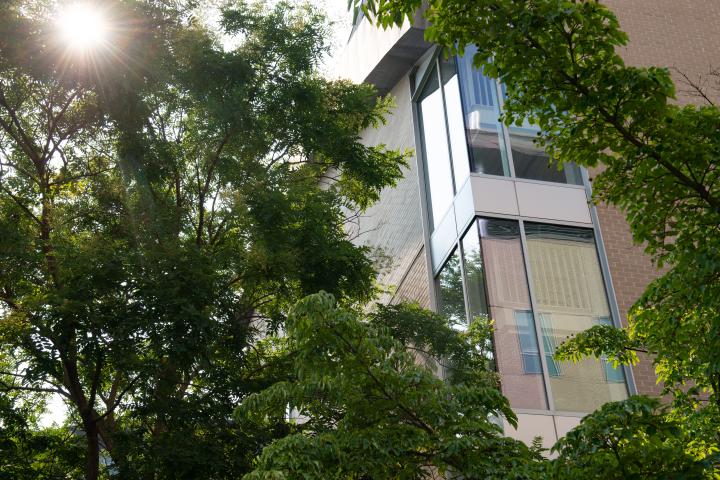October 28, 2021
A solar energy project that’s been in the works for several years continues to march forward, bringing Olin ever closer to producing more renewable energy.
In summer 2019, Energy and Sustainability Interns Ana Krishnan ’20 and George Tighe ’22 were reviewing Olin’s Sustainability Tracking, Assessment & Rating System (STARS) report, a widely used, self-reporting framework to measure sustainability performance in higher education. They noticed that the energy section—one of many assessment areas ranging from academics to transportation—had room for improvement.
Jeremy Goodman agreed. In 2019, as the newly appointed Vice President for Administrative Services and Innovation, Goodman asked Claire Rodgers, associate energy engineer on the Facilities team, to investigate carbon reduction options for the campus, including introducing solar power. Under the guidance of Rodgers, Krishnan and Tighe embarked on a project to review ways to lower Olin’s carbon emissions.
“They came up with 11 different criteria that were important to viewing the project holistically—cost, maintenance, educational value—and researched different energy options, such as solar, geothermal, wind, and fuel cells,” said Rodgers. “They presented their findings to Jeremy, which was a pretty cool experience for them.”
“It was very uplifting to present the results of our study and our recommendation for the solar carport project to Jeremy,” said Tighe. “Many Oliners successfully take agency through such sustainability initiatives, and it'll be a major step forward for Olin to produce its own renewable energy.”
The students recommended solar energy as the way to move forward. Interestingly, this idea had been on Olin’s radar for a while, but due to a multitude of factors it hadn’t moved forward yet. Now, thanks to new incentive programs, student initiative, and support from the Sustainability Steering Committee—chaired by Rodgers—the time was ripe to take another serious look at solar on campus.
After some preliminary work, the Committee hired Sage Energy Consulting out of California in early 2020 to provide their expertise and complete a feasibility study.
A year later, Goodman presented the results to the Finance & Facilities Committee of the Board of Trustees, highlighting not only Sage’s confirmation that solar energy was the right choice for Olin, but also underscoring why sustainability is so important to the college and its community.
“Over the intervening years, a lot had happened in the sustainability space at Olin,” said Rodgers. “Olin added the E:Sustainability concentration, created the Eco-Reps program, formed a partnership with Greentown Labs, and more—all things that link to our mission and vision to better the world.”
“We have the perfect conditions to turn commitment to action and to create meaningful learning experiences for Olin students while we do it. It has taken us a lot of effort to get to this point and it is immensely gratifying to see this project moving forward,” said Goodman.
Students, staff, and faculty are working together to generate solar energy on campus.
See More: Students Collaborate on K-12 Outreach
The presentation was a success, and the Board approved the solar project to move to the request for proposal (RFP) phase with the understanding that the project will move forward to construction pending any unforeseen issues. To facilitate, Goodman and Rodgers formed a dedicated Solar Team with representatives from across campus to make sure the project is integrated into the entire Olin experience. Individuals from marketing, post-graduate planning, faculty, and more are brainstorming to capture as many impactful ideas into the RFP as possible.
“Right now, we’re collecting ideas to share with Sage to see if we can find an organization who wants to be more than a transactional partner and instead involve students in deeper partnerships,” said Rodgers.
“This is larger than just putting solar panels on campus—this is another way in which Olin is a living lab for learning and growth."
While the exact details and timing of the solar project will be forthcoming once a contractor is selected, the RFP will stipulate that much of the work be focused on spacious Parking Lot A, which is relatively south-facing—Sage’s suggestion based on their feasibility work. The RFP will also ask companies to put forth their own creative ideas to ensure Olin finds a partner with an exciting vision for this new chapter in sustainability on campus.